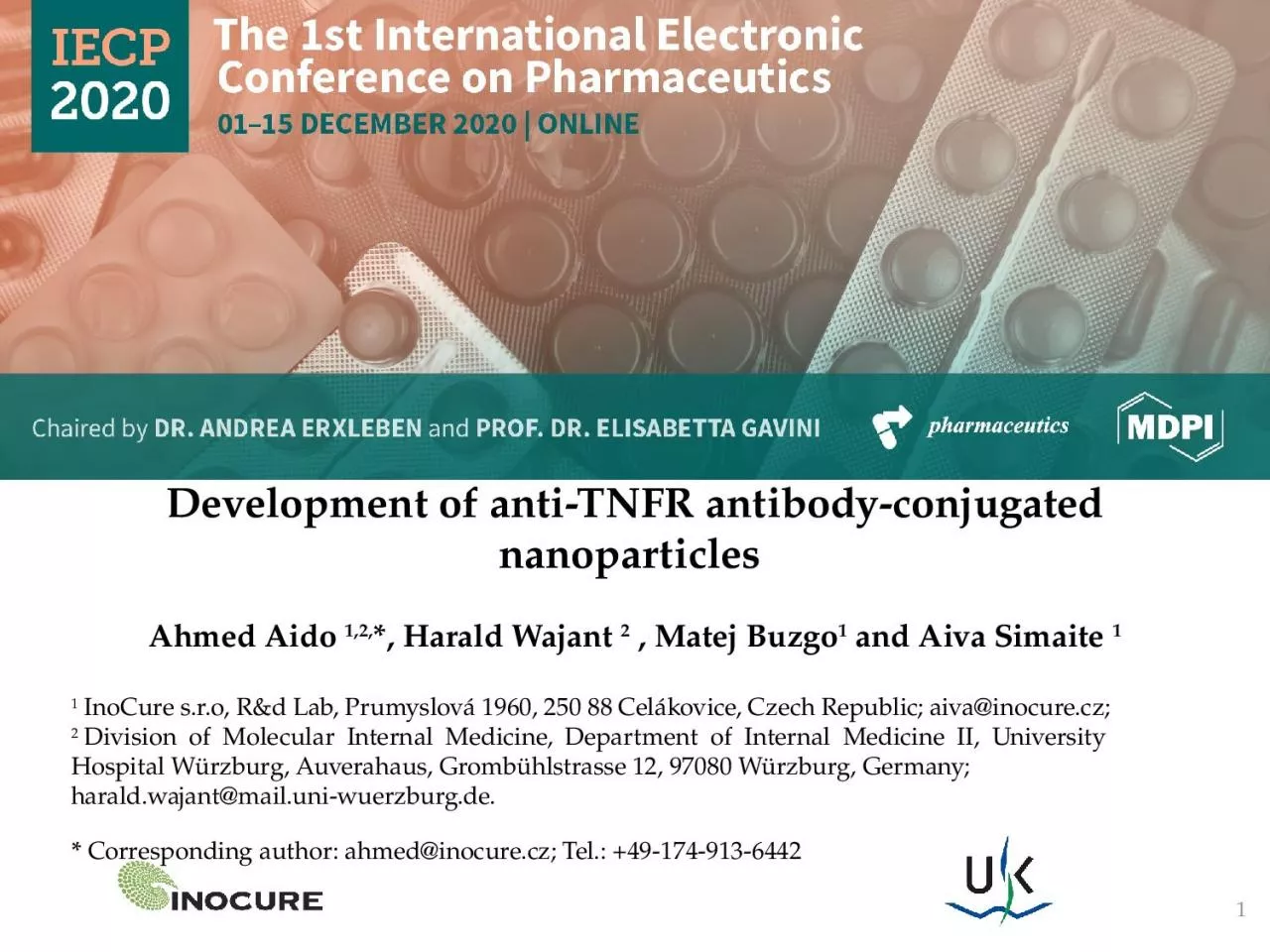

Ahmed Aido 12 Harald Wajant 2 Matej Buzgo 1 and Aiva Simaite 1 1 InoCure sro Rampd Lab Prumyslová 1960 250 88 Celákovice Czech Republic aivainocurecz ID: 1040928
Download Presentation The PPT/PDF document "Development of anti-TNFR antibody-conjug..." is the property of its rightful owner. Permission is granted to download and print the materials on this web site for personal, non-commercial use only, and to display it on your personal computer provided you do not modify the materials and that you retain all copyright notices contained in the materials. By downloading content from our website, you accept the terms of this agreement.
1. Development of anti-TNFR antibody-conjugated nanoparticles Ahmed Aido 1,2,*, Harald Wajant 2 , Matej Buzgo1 and Aiva Simaite 11 InoCure s.r.o, R&d Lab, Prumyslová 1960, 250 88 Celákovice, Czech Republic; aiva@inocure.cz; 2 Division of Molecular Internal Medicine, Department of Internal Medicine II, University Hospital Würzburg, Auverahaus, Grombühlstrasse 12, 97080 Würzburg, Germany; harald.wajant@mail.uni-wuerzburg.de. * Corresponding author: ahmed@inocure.cz; Tel.: +49-174-913-64421
2. Abstract: Immunotherapy is considered as a new pillar of cancer treatment. However, the application of some promising immunotherapeutic antibodies, such as antibodies against certain immune-stimulatory receptors of the TNF receptor superfamily (TNFRs) including CD40, 41BB, CD27 and anti-fibroblast growth factor-inducible 14 (anti-Fn14) are limited due to their low bioactivity. It has been previously shown that the bioactivity of such anti-TNFR antibodies could be improved by crosslinking or attachment to the plasma membrane by interaction with Fcγ receptors (FcγR). Both result in proximity of multiple antibody-bound TNFR molecules what allows activation of proinflammatory signaling pathways. In this work, we have grafted antibodies on gold nanoparticles to simulate the “activating” effect of FcγR-bound and thus plasma membrane-presented anti-TNFR antibodies. We have developed and optimized the method for the preparation of gold nanoparticles, their functionalization with poly-ethylene glycol (PEG) linkers, and grafting of antibodies on the surface. We showed here that antibodies, including the anti-Fn14 antibody PDL192, can be successfully attached to nanoparticles without affecting antigen binding. We hypothesize that conjugation of monoclonal anti-TNFR antibodies to the inorganic nanoparticles is a promising technique to boost the efficacy of these immunotherapeutic antibodies.Keywords: Nanoparticles; Surface modification; Drug-delivery, agonistic anti TNFRSF receptor (TNFR) antibody2
3. Introduction and keywords 31. Addaptive and Innative Immunoresponse 2. TNFSF ligand and TNFRSF receptors3. Single chaine variable domaine scFv as an anchoring domainDomain architecture of a TNFRSF death receptorDomain architecture of the TNF ligand
4. Aim of the work41. Immobilizing the bio molecules.To enhance the activity of the antibody2. Encapsulation of the bio molecules:To enable release-on-demand (cleavable peptides, etc.)To eliminate systemic side effect
5. Results and Discussion5Optimized protocol of synthesis and C-AuNPs ca. 86 nm .Reduction of Au+ (HAuCl4) with Trisodium citrate.1. The size of the particles can be controlled by the concentration of Auric salt or Trisodium citrate.2. Longer boiling duration increases the concentration with the same size.
6. Results and Discussion6AuNPs Colloid's stability can preserved by functionalization with carboxyl-PEG.The size of AuNPs increases after the PEGylation.
7. Results and Discussion7AuNPs Colloid's stability can preserved by functionalization with carboxyl-PEG.The negative charge on the surface of the particles increases after the PEGylation.Sample structure Particles Sizeζ potentialTrisodium citrate - AuNPs 60.19 nm-14 mvmPEG-AuNPs80.45 nm-7 mvHOOC-PEG-AuNPs86.5 nm-20 mv
8. Results and Discussion8Using EDC/NHS Covalent Coupling ProcedureThe size of the AuNPs has been slightly increases after the grafting Grafting the carboxyl-modified AuNPs with the protein of interest
9. Results and Discussion9Using EDC/NHS Covalent Coupling ProcedureC-AuNPs can be coupled with different types of therapeutic antibodies without affecting their activity.
10. Results and Discussion10The max grafting capacity on AuNPs (25mg/ml-60nm) is around 250 (μg/ml)
11. 11ConclusionsGold nanoparticles of diameter ca. 60 nm have been synthesized by sodium citrate reduction of gold chloride.Functionalization with COOH-PEG-SH stabilize the colloidal solution of the gold nanoparticles and help to cross link them with antibodies. The carboxyl-modified gold nanoparticles can be coupled with the antibodies of interest using the EDC/NHS coupling procedure without affecting their activity. Our future work will focus on the in vitro assays to compare the activity of the conjugated antibodies and their soluble variants.
12. AcknowledgmentsGrant Agreement number: 813871 — I-DireCT — H2020-MSCA-ITN-201812This is a part of project which has received funding from the European Union’s Horizon 2020 research and innovation programme under the Marie Sklodowska-Curie grant agreement No 813871.